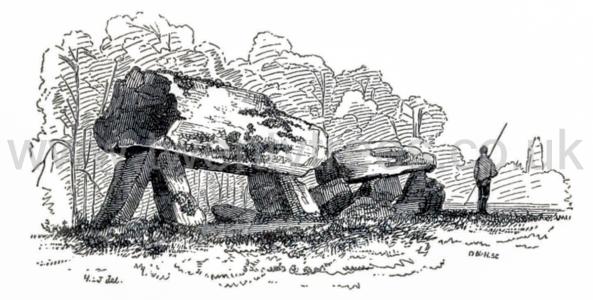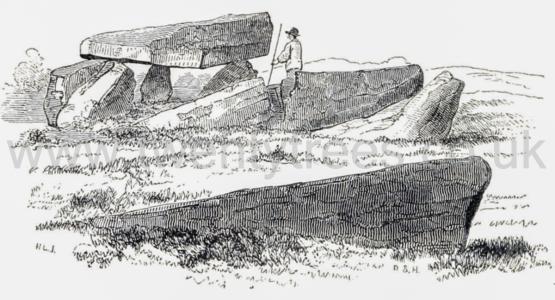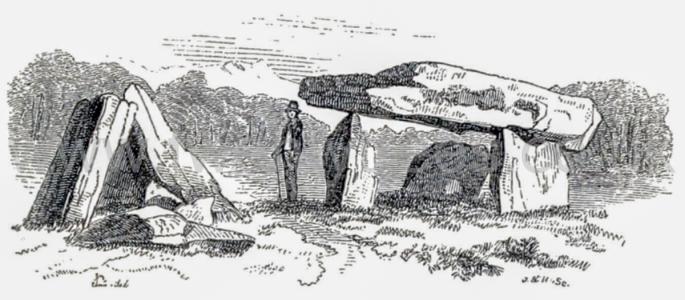Archaeological Journal Volume 3 Page 39
Archaeological Journal Volume 3 Page 39 is in Archaeological Journal Volume 3.
1846. Archaeological Journal Volume 3 (1846). On the Cromlechs extant in the Isle of Anglesey By Harry Longueville Jones (age 40).
A great step has been made in the history of Celtic Monuments by the researches of antiquaries among the traditions and the monuments of ancient Britain, as well as by those acute observers, who, like Mr. Lukis (age 57) and some of his contemporaries, have had the good fortune to find cromlechs almost untouched by the hands of the vulgar, and who have shewn them, by their contents, to have been places of sepulture, not of barbarous sacrifices and ceremonies. The quantity of conjecture and of guess work, that was issued during the latter end of the last century upon this subject, was astonishing: no antiquary of that time could be said to have fairly won his title unless he had advanced some new hypothesis, or suggested some new idea as to the destination of the cromlechs. They were proved to be altars, temples, houses, any thing in fact that their examiners,-or rather those that had not examined them,-thought proper to conjecture: the fact of their being in wild parts of the country went for a good deal, and the circumstance of the top stone sloping generally to one side or the other, enabled the clear-sighted to see streams of blood running off them from the quivering limbs of unhappy victims. Even bones were found near them-sometimes under them-and (the victims having been slaughtered above,-at least in the imaginations of the enquirers) they were of course the remains of the wretched creatures who had been immolated to the false gods of our heathen ancestors. Capital theories! excellent discoveries!-until in some luckless hour, an observer more far-sighted than the rest bethought himself of digging into a tumulus, and then he disinterred-not a body,-but a cromlech full of bodies:-and another dug under a cromlech divested of its original earthen envelope, and he too found bodies;-in fact they turned out to be enormous coffins, or cistvaens, or vaults, (if it were not an anomaly so to style them,) houses in good truth,-houses not of the living, but the dead:-the true λαινον χιτωνα of Homer;-the "narrow home" of a later poet [Note. Possible a reference to "Into the Narrow Home" by Branwell Brontë]. In few instances has the value of accurate searching enquiry, and of good common sense, in antiquarian affairs been more strikingly demonstrated: and we consider the public to be most especially indebted to Mr. Lukis (age 57) for his interesting researches in this line in the Channel Islands.
There are numerous cromlechs extant in the Isle of Anglesey, though, we believe, not so many above ground as Bingley (a second hand and superficial observer) would have us suppose. He assigns twenty-eight, according to the number furnished by his informants, for he never went near most of the localities, upon which he places them; but several of them he puts down under different names twice or thrice over:- and in some instances they have no existence. It is probable that the number of cromlechs actually visible in Anglesey may approach to twenty: but we suspect that there are many others, which have never seen light since their first interment, and we know that the ranges of the Caernarvonshire and Merionethshire mountains are full of them,-subterraneous, if not on the surface,-for we have found and seen many ourselves.
The judicious Pennant mentions none but those that he had actually seen, and hazards few conjectures as to their use and destination; all other writers follow either Pennant or Bingley.
One of the most stupendous cromlechs, if it be a cromlech, in this or any other island, is that which is commonly so called on the lands of C. Evans, Esq., at Hên Bias, not far from the Mona Inn in the middle of the county. Here there are two rocks, each about seventeen feet high, by nearly as many in thickness and breadth, standing upright; and between them, partially resting on that to the eastward, is another flattish mass, a little smaller in size, which certainly looks as if it had slidden from off the tops of its neighbours. There are no other rocks within a mile or two of the place, except at a small range of rocky hills separated from it by a stream:-and we can hardly imagine how such great masses, of nearly 5000 cubic feet each, could have been moved in remote ages. We are inclined to look upon this assemblage of rocks, which however tradition calls "the cromlech," as the disintegrated ruin of some hill which once existed here. The only thing that staggers us in this hypothesis is a further tradition of smaller stones, apparently forming a kind of avenue, having once stood close by. If this tradition be allowed to have authority,-and tradition is very often no unsafe guide,-then this cromlech should be called the father of all others:-for it is a true giant among pigmies.
The most celebrated cromlech in the island is that of Plas Newydd [Map], of which we have given a view. It is a double cromlech-as about one half of these monuments always are-and is interesting from its fine preservation and highly picturesque position. We are not aware of any excavations having been made beneath it: but there is every appearance, from the formation of the ground, of its having been once surrounded by a carn or heap of stones; what the second and smaller cromlech meant in these cases, we do not know; probably it served as the tomb of the wife, or the son, of the deceased chieftain. Rowlands mentions a large carn or mound of stones as not far from this cromlech, but grown over, even in his days, by a luxuriant vegetation of wood. There are so many points of the undulating and richly wooded grounds of the Marquis of Anglesey's seat, corresponding to this description, that we do not know how to fix upon the precise locality, but we have little doubt, from the words of the author of the "Mona Antiqua," that, could this mound be excavated, we should find in it a sepulchral chamber con- structed in the true cromlech fashion. On a farm in this immediate neighbourhood at a spot called Bryn Celli, is a tumulus with a passage opened right through it, this passage descends towards the middle of the mound, and then again mounts to upper air: in the middle we come to a chamber, if it can be so called, which is nothing more nor less than the interior of a cromlech; Gough, in his addition to Camden, gives an account of it, and it is there mentioned as having been found to contain human bones; at present it is a refuge for sheep in wet weather.

A remarkably fine remain of this nature is the cromlech at Llanfaelog [Map] of which we append a representation; the cromlech still standing is composed of one flat on several upright stones; the flat top being about 12ft. by 9ft. in breadth, and from 2 ft. to 3 ft. in thickness. By its side lie the fallen remains of a much larger cromlech, the upper stone of which is not less than 15 ft. in length; underneath the upright one are still to be seen numerous small stones, and the ground rises gently toward the upright supports on all sides; but on referring to Pennant, vol. ii. p. 238, we find him saying (in speaking of cromlechs) "others again are quite bedded in the Carnedd or heap of stones, of which instances may be produced in Llanfaelog, in this island, in that of Arran, and in the county of Meireonedd." If then this cromlech could have been so stripped of its covering since the end of the last century, what may we not expect to have taken place in other instances?

Another cromlech, we have been informed, quite surrounded with stones and earth, has been found in the same parish by the Rev. C. H. Hartshorne.
A smaller cromlech, on gently rising ground, is still standing at Bodowyr, a few miles south-west of Plas Newydd.
The next in size and importance to that on the Marquis of Anglesey's grounds, are those at Presaddfed [Map] near Bodedern.
Of these too we give a view, by which it will be seen that one of very large size is still erect, while another close to it is partially fallen down; the former offers a shelter of at least 12 ft. square to the farmer and a party of six or eight labourers, whenever they are overtaken in their work by a sudden shower; the cattle commonly take refuge under it, and it is surrounded by a great number of small stones, affording a strong presumption that here too there was once a carn.

In all these cases the cromlechs are composed of stones found in their immediate neighbourhood; thus, those at Plas Newydd, Bodowyr, and one at Llanidan, are of limestone rock found there in situ: those at Llanfaelog and Presaddfed are of the peculiar porphyritic breccia which accompanies the schistose formation of those districts. The cromlechs at Llugwy and in its vicinity are of limestone, and at Trefor [Map] of chloritic schist, thus affording the inference that they could not have been brought from any considerable distance. The immense rocks at Hên Bias are of the limestone of that spot, on which indeed they stand.
On the hills of Caernarvonshire may be found numerous carns (or carneddau) opened by some previous examiners, (tradition says, by robbers in search for gold,) and in the midst are still to be seen the upright stones of the coffin or tomb, with the upper slanting stone (or cromlech) thrust off and lying by their side. We apprehend that Wales is full of such remains, and could they be exhumed, under proper authority, the result would be very valuable for the advancement of our archæological knowledge. We have never heard of celts, or pottery-ware, or other articles having been found near any of these cromlechs; but the search for these matters can be said to have only just commenced, and we may yet discover them.
H. Longueville Jones.